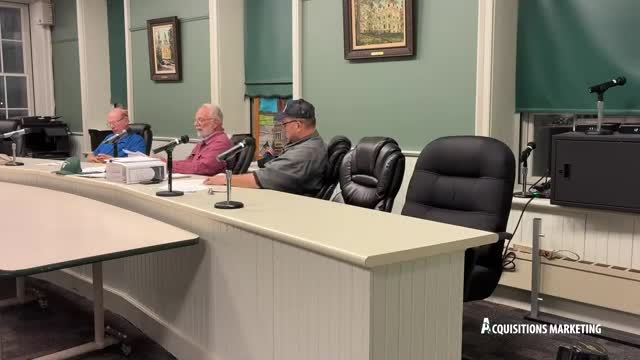Reviewers flag fire, groundwater and emergency-response gaps in Hartley Road battery storage submission
October 09, 2025 | Goshen, Orange County, New York
This article was created by AI summarizing key points discussed. AI makes mistakes, so for full details and context, please refer to the video of the full meeting. Please report any errors so we can fix them. Report an error »

Planning reviewers told project applicants and staff they need more detail before the board can assess a battery energy storage system (BESS) proposed for 114 Hartley Road. The committee's concerns centered on fire behavior of large battery arrays, potential for contaminants to reach groundwater, and gaps in emergency response and evacuation planning for adjacent facilities and large public events.
The applicant submitted supplemental materials and a hazard-mitigation narrative identifying that the site lies within an aquifer overlay. The applicant's materials assert the facility is unlikely to have an adverse groundwater impact, and noted emergency response plans that do not rely on direct water-based fire suppression. Reviewers contested that conclusion and asked for detail on several points: whether and how batteries might leak chemicals into soil when damaged or exposed to firefighting water; how long a thermal event could burn and whether re-ignitions are possible; whether containment or diversion for contaminated firefighting runoff would be provided; and whether on-site vents and automatic venting mechanisms address the spectrum of possible failures.
Reviewers also said the applicant's characterization that the storage "containers" are not buildings must be clarified: the facility includes access doors and spaces that will require maintenance access and emergency procedures. Committee members recounted examples from other jurisdictions where battery fires burned for days to weeks and rekindled after appearing extinguished, and noted that firefighting water or foam used on a BESS can itself become contaminated and pose a disposal problem.
Public-safety logistics drew extended discussion. Committee members asked whether local first responders have equipment and protocols to protect personnel near a battery fire, whether mutual-aid HAZMAT teams could arrive within the regulatory timelines the applicant cited, and how evacuation notifications would reach workers, residents and large-event attendees at nearby venues. Reviewers recommended applicant coordination with the local fire chief, police and county HAZMAT teams to develop concrete operational protocols: wind-monitoring at the site to determine safe approach vectors, staging and set-back distances for responders, a clear plan for protecting adjacent residents and businesses, and an agreed process for contaminated runoff collection and disposal. One reviewer noted the county HAZMAT standard that a qualified responder be reachable within 15 minutes and on-site within a stated timeframe; reviewers asked the applicant to identify the specific response provider and their response-time commitments.
The committee requested documented answers to these technical and operational questions before acting on any special-use or site-plan applications, and suggested the town seek comparisons with jurisdictions that have operated and remediated BESS incidents. Reviewers did not make a final determination at the meeting; they signaled that further written material and fire-department coordination would be necessary for the board's review.
The applicant submitted supplemental materials and a hazard-mitigation narrative identifying that the site lies within an aquifer overlay. The applicant's materials assert the facility is unlikely to have an adverse groundwater impact, and noted emergency response plans that do not rely on direct water-based fire suppression. Reviewers contested that conclusion and asked for detail on several points: whether and how batteries might leak chemicals into soil when damaged or exposed to firefighting water; how long a thermal event could burn and whether re-ignitions are possible; whether containment or diversion for contaminated firefighting runoff would be provided; and whether on-site vents and automatic venting mechanisms address the spectrum of possible failures.
Reviewers also said the applicant's characterization that the storage "containers" are not buildings must be clarified: the facility includes access doors and spaces that will require maintenance access and emergency procedures. Committee members recounted examples from other jurisdictions where battery fires burned for days to weeks and rekindled after appearing extinguished, and noted that firefighting water or foam used on a BESS can itself become contaminated and pose a disposal problem.
Public-safety logistics drew extended discussion. Committee members asked whether local first responders have equipment and protocols to protect personnel near a battery fire, whether mutual-aid HAZMAT teams could arrive within the regulatory timelines the applicant cited, and how evacuation notifications would reach workers, residents and large-event attendees at nearby venues. Reviewers recommended applicant coordination with the local fire chief, police and county HAZMAT teams to develop concrete operational protocols: wind-monitoring at the site to determine safe approach vectors, staging and set-back distances for responders, a clear plan for protecting adjacent residents and businesses, and an agreed process for contaminated runoff collection and disposal. One reviewer noted the county HAZMAT standard that a qualified responder be reachable within 15 minutes and on-site within a stated timeframe; reviewers asked the applicant to identify the specific response provider and their response-time commitments.
The committee requested documented answers to these technical and operational questions before acting on any special-use or site-plan applications, and suggested the town seek comparisons with jurisdictions that have operated and remediated BESS incidents. Reviewers did not make a final determination at the meeting; they signaled that further written material and fire-department coordination would be necessary for the board's review.
View the Full Meeting & All Its Details
This article offers just a summary. Unlock complete video, transcripts, and insights as a Founder Member.
✓
Watch full, unedited meeting videos
✓
Search every word spoken in unlimited transcripts
✓
AI summaries & real-time alerts (all government levels)
✓
Permanent access to expanding government content
30-day money-back guarantee

